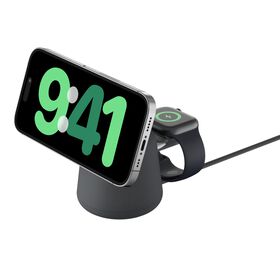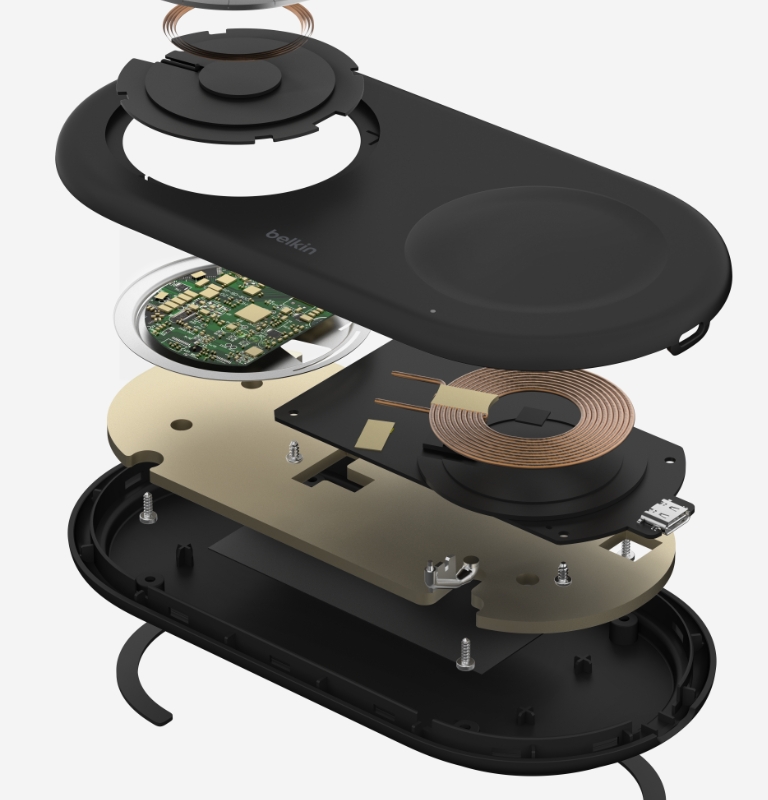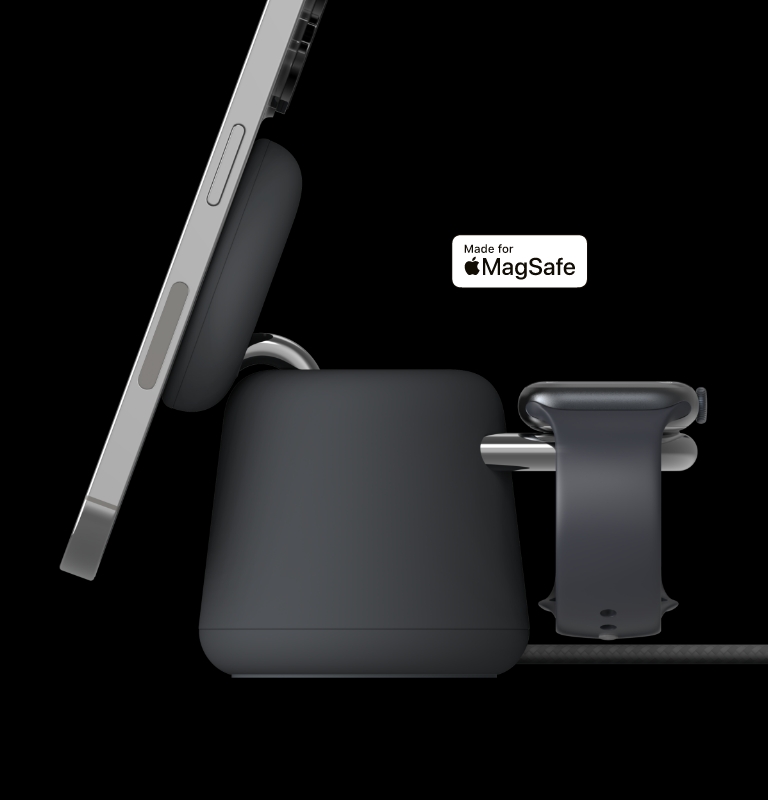Cliquez ici pour en savoir plus sur les chargeurs sans fil pour smartphones.
FAQ : les chargeurs sans fil
Les chargeurs sans fil pour smartphones vous permettent de recharger votre téléphone sans l’aide de câble de recharge. Il vous suffit de poser votre appareil sur le chargeur (socle, support ou station de recharge) et ce dernier active la recharge en utilisant le champ magnétique. La puce électronique intégrée au chargeur contrôle le processus de recharge afin de vous offrir une recharge sécurisée qui n’endommage pas votre téléphone. Cliquez ici pour en savoir plus sur son mode de fonctionnement.
Qu'ils soient magnétiques ou non, les chargeurs à induction sont sans danger pour la batterie de vos appareils. La batterie d'un appareil s'use avec le temps, lentement, après de nombreuses recharges. Laisser votre appareil branché ou connecté à votre chargeur peut avoir un impact négatif sur l'autonomie de sa batterie. Il est recommandé de débrancher ou de déconnecter l’appareil une fois qu’il est entièrement rechargé. Cliquez ici pour en savoir plus sur les normes de sécurité.
Appareils Apple : iPhone 8 (ou version ultérieure)
Appareils Samsung : Smartphones Galaxy Note : Galaxy Note20 5G, Note20 Ultra 5G, Note10+, Note10, Note9, Note8 et Note 5, Smartphones Galaxy S : gamme S23, gamme S22, gamme S21, gamme S20, gamme S10, gamme S9, gamme S8, gamme S7 et gamme S6, Smartphones pliables : Galaxy Z Fold, Z Fold2, Z Fold3, Z Fold4, Z Flip, Z Flip 5G, Z Flip3 et Z Flip4
Appareils Google Pixel : Pixel 3, Pixel 3 XL, Pixel 4, Pixel 4 XL, Pixel 5, Pixel 6, Pixel 6Pro, Pixel 7, Pixel 7 Pro
Pour utiliser un chargeur sans fil, il vous suffit de le brancher sur une source d’alimentation et de poser dessus votre appareil compatible. Assurez-vous que votre téléphone est centré et aligné. Un voyant lumineux vous indiquera la mise en route de la recharge de votre appareil. Tous les appareils ne sont pas compatibles avec les chargeurs sans fil. Vérifiez les spécifications techniques de votre appareil et assurez-vous qu’il est bien compatible avec votre chargeur et la technologie de recharge sans fil utilisée.
Les stations de recharge à induction utilisent une technologie de recharge connue sous le nom de Qi. Cette technologie transfère l’énergie électrique de manière sans fil, du chargeur vers l’appareil à recharger. Tout se passe entre deux bobines, celle se trouvant dans le chargeur et celle intégrée à l'appareil à recharger. Ce phénomène génère un champ électromagnétique. La plupart des chargeurs sans fil sont équipés de modules de recharge MagSafe, Qi ou Qi2. La liste des appareils compatibles, la vitesse de recharge, etc. varient et dépendent de la technologie de recharge sans fil intégrée au chargeur sans fil.
Les stations de recharge sans fil fonctionnent comme les chargeurs à induction, à la différence près qu’elles permettent de poser l’appareil mobile de façon inclinée. Elles utilisent une recharge par induction qui consiste à transférer l’énergie électrique de manière sans fil, du chargeur vers l’appareil à recharger. Le chargeur possède une bobine de cuivre qui créé un champ électromagnétique. L'appareil mobile dispose d'une bobine similaire qui réceptionne ce champ électromagnétique pour recharger sa batterie. La plupart des stations de recharge utilisent le protocole de recharge sans fil Qi qui permet d'optimiser le processus de recharge en ajustant la puissance et la vitesse de recharge. Ces stations de recharge ont la particularité de positionner l'appareil en mobile de façon inclinée.
La plupart des iPhone de nouvelle génération sont dotés de la fonction de recharge sans fil Voici la liste des modèles d'iPhone dotés de cette fonctionnalité :
- iPhone 8 (ou version ultérieure) : tous les modèles de cette gamme prennent en charge la fonction de recharge sans fil
- iPhone X (ou version ultérieure) : iPhone X, XS, XS Max, XR et modèles récents.
- iPhone 11 : iPhone 11, 11 Pro et 11 Pro Max.
- iPhone 12 : iPhone 12, 12 mini, 12 Pro et 12 Pro Max. Ces modèles prennent aussi en charge la fonction de recharge MagSafe.
- iPhone 13 : iPhone 13, 13 mini, 13 Pro et 13 Pro Max. Ces modèles prennent aussi en charge la fonction de recharge MagSafe.
- iPhone 14 : iPhone 14, 14 mini, 14 Pro et 14 Pro Max. Ces modèles prennent aussi en charge la fonction de recharge MagSafe.
Oui, plusieurs smartphones Samsung prennent en charge la recharge sans fil. Voici la liste des modèles Samsung prenant en charge la recharge sans fil :
- Galaxy S : Samsung Galaxy S6 (ou version ultérieure) : Galaxy S6, S6 Edge, S7, S7 Edge, S8, S8+, S9, S9+, S10e, S10, S10+, S20, S20+, S21, S21 Ultra, S22, S22+, S22 Ultra, S23, S23+, and S23 Ultra.
- Galaxy Note : Galaxy Note 5 (ou version ultérieure) : Note 8, Note 9, Note 10, Note 10+, Note 20, Note 20 Ultra.
- Galaxy Z : Galaxy Z Fold et Z Flip : Z Fold 2, Z Fold 3, Z Fold 4, Z Flip, Z Flip 5, etc.
- Galaxy A : certains modèles uniquement comme le Galaxy A80, A90 ou A91
- Galaxy M : certains modèles uniquement et généralement ceux de la gamme Galaxy M, une famille de produits peu onéreux dépourvus de la fonction de recharge sans fil
Oui, plusieurs smartphones Android prennent en charge la recharge sans fil. Il s'agit généralement des modèles milieu-de-gamme et haut-de-gamme. Voici la liste des smartphones Android dotés de la fonction de recharge sans fil :
- Google Pixel : Pixel 3 (ou version ultérieure) : Pixel 3, Pixel 3 XL, Pixel 4, Pixel 4 XL, Pixel 5, Pixel 6, Pixel 6 Pro, Pixel 7 et Pixel 7 Pro. Tous ces modèles prennent en charge la recharge sans fil.
- Samsung Galaxy : Galaxy S : à partir du Galaxy S6, la plupart des modèles de cette gamme prennent en charge la recharge sans fil.
- Galaxy Note : à partir du Note 5, y compris le Note 20 Ultra.
- Galaxy Z : tous les modèles de la gamme comme le Galaxy Z Fold et Z Flip
- OnePlus : OnePlus 8 Pro (ou version ultérieure) comme le OnePlus 8 Pro, OnePlus 9 Pro ou OnePlus 10 Pro prennent en charge la recharge sans fil. Les modèles antérieures ne prennent pas en charge cette fonctionnalité.
- Xiaomi : Mi Mix 4 (ou version ultérieure) comme Mi 11 et Mi 11 Ultra sont compatibles avec la recharge sans fil.
- Sony : Xperia 1 (ou version ultérieure) comme le Xperia 1 II, Xperia 1 III ou encore les modèles récents du Xperia sont compatibles avec la recharge sans fil.
- Oppo : Find X ou les modèles comme Oppo Find X3 Pro prennent en charge la fonction de recharge sans fil.
- Huawei : P40 Pro (ou version ultérieure) comme le Huawei P40 Pro, Mate 40 Pro sont compatibles avec la recharge sans fil.
- Autres marques : LG comme le LG V30, V35, V40 et G7 ThinQ prennent en charge la recharge sans fil bien que la marque LG n'existe plus sur le marché des smartphones. Asus : certains modèles comme le ROG Phone 5 prennent en charge la recharge sans fil.
Les chargeurs pour iPhone ne ressemblent pas aux chargeurs pour Samsung et plusieurs critères les différencient comme la compatibilité, la vitesse de recharge, le design ou autre fonctionnalité. Voici ci-dessous les différents critères en question :
1. Compatibilité
- iPhone : recharge standard Qi et MagSafe (pour l'iPhone 12 ou version ultérieure). La technologie MagSafe offre un meilleur alignement et jusqu'à 15 W de puissance.
- Smartphones Samsung : recharge standard Qi. La plupart des modèles Samsung se rechargent jusqu'à 10 W, mais certains peuvent être rechargés jusqu'à 15 W avec des chargeurs Samsung sans fil rapides.
2. Vitesse de recharge
- iPhone : jusqu'à 7,5 W avec des chargeurs standard Qi. Et jusqu'à 15 W avec des chargeurs MagSafe.
- Smartphones Samsung : jusqu'à 10 W avec des chargeurs standard Qi. Et jusqu'à 15 W avec des chargeurs sans fil rapides Samsung.
3. Le design et les caractéristiques
- Chargeurs MagSafe pour iPhone : alignement magnétique, design fin, intégration avec les accessoires MagSafe.
- Chargeurs sans fil Samsung : design multiple (socle ou support de recharge), fonctionnalités supplémentaires comme système de ventilation interne, et recharge simultanée de plusieurs appareils.
4. Prix
- Chargeurs MagSafe : ces produits sont généralement onéreux, car ils sont équipés d'une technologie dite « propriétaire ».
- Chargeurs sans fil Samsung : ces produits sont disponibles à des prix variables, mais généralement peu onéreux, avec des fonctionnalités intégrées.
La puissance des chargeurs varient selon le type d'appareil mobile à recharger. Voici ci-dessous un aperçu :
1. La recharge sans fil standard
- iPhone : jusqu'à 7,5 W en utilisant des chargeurs compatibles Qi
- Smartphones Samsung : jusqu'à 10 W en utilisant des chargeurs compatibles Qi (bien que certains modèles prennent en charge des puissances plus élevées).
2. La recharge sans fil rapide
- iPhone : jusqu'à 15 W en utilisant des chargeurs MagSafe d'Apple pour iPhone 12 (ou version ultérieure).
- Smartphones Samsung : jusqu'à 15 W en utilisant des chargeurs rapides Samsung, comme ceux du Galaxy S21 Ultra ou Note 20 Ultra.
Les puissances de recharge en bref
- Recharge standard de l'iPhone : 7,5 W
- Recharge MagSafe de l'iPhone : jusqu'à 15 W
- Recharge standard du Samsung : jusqu'à 10 W
- Recharge rapide du Samsung : jusqu'à 15 W
Remarque : La puissance réelle peut varier selon plusieurs facteurs comme l'épaisseur de la coque de protection du smartphone, l'alignement du smartphone avec le chargeur et la puissance de sortie du chargeur. Découvrez ici la recharge sans fil rapide.










